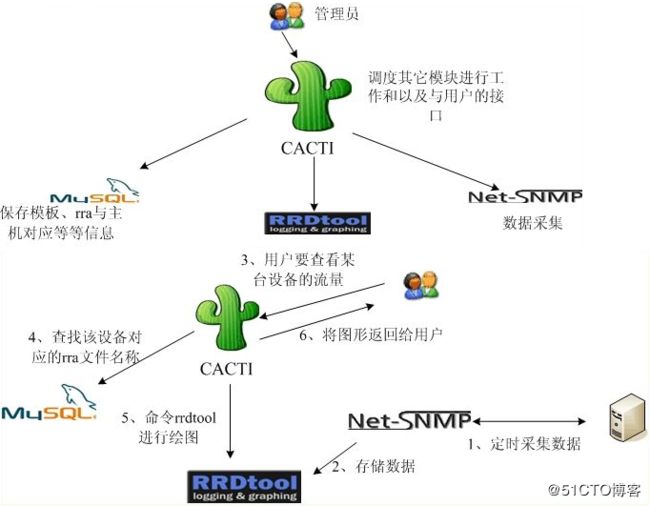一、Cacti介绍
以下为cacti官网介绍:
Cacti is a complete network graphing solution designed to harness the power of RRDTool's data storage and graphing functionality. Cacti provides a fast poller, advanced graph templating, multiple data acquisition methods, and user management features out of the box. All of this is wrapped in an intuitive, easy to use interface that makes sense for LAN-sized installations up to complex networks with thousands of devices.
Cacti is a complete frontend to RRDTool, it stores all of the necessary information to create graphs and populate them with data in a MySQL database. The frontend is completely PHP driven. Along with being able to maintain Graphs, Data Sources, and Round Robin Archives in a database, cacti handles the data gathering. There is also SNMP support for those used to creating traffic graphs with MRTG.
(网上图片)
Data Sources:
To handle data gathering, you can feed cacti the paths to any external script/command along with any data that the user will need to "fill in", cacti will then gather this data in a cron-job and populate a MySQL database/the round robin archives.
Data Sources can also be created, which correspond to actual data on the graph. For instance, if a user would want to graph the ping times to a host, you could create a data source utilizing a script that pings a host and returns it's value in milliseconds. After defining options for RRDTool such as how to store the data you will be able to define any additional information that the data input source requires, such as a host to ping in this case. Once a data source is created, it is automatically maintained at 5 minute intervals.
Graphs:
Once one or more data sources are defined, an RRDTool graph can be created using the data. Cacti allows you to create almost any imaginable RRDTool graph using all of the standard RRDTool graph types and consolidation functions. A color selection area and automatic text padding function also aid in the creation of graphs to make the process easier.
Not only can you create RRDTool based graphs in cacti, but there are many ways to display them. Along with a standard "list view" and a "preview mode", which resembles the RRDTool frontend 14all, there is a "tree view", which allows you to put graphs onto a hierarchical tree for organizational purposes.
User Management:
Due to the many functions of cacti, a user based management tool is built in so you can add users and give them rights to certain areas of cacti. This would allow someone to create some users that can change graph parameters, while others can only view graphs. Each user also maintains their own settings when it comes to viewing graphs.
Templating:
Lastly, cacti is able to scale to a large number of data sources and graphs through the use of templates. This allows the creation of a single graph or data source template which defines any graph or data source associated with it. Host templates enable you to define the capabilities of a host so cacti can poll it for information upon the addition of a new host.
Cacti requires MySQL, PHP, RRDTool, net-snmp, and a webserver that supports PHP such as Apache or IIS. Please see the requirements section of the manual for information on how to fulfill these requirements under certain operating systems. Please use the install guide for either Unix or Windows for information about installing Cacti.
Cacti requires that the following software is installed on your system.
RRDTool 1.0.49 or greater, 1.4+ recommended
MySQL 5.x or greater
PHP 5.1 or greater
Web Server that supports PHP e.g. Apache or IIS
二、Weathermap0.9.8a介绍
https://www.network-weathermap.com/

